Please enter your username or email address. You will receive a link to create a new password via email.

Redlux Properties Team listings sell for 7.2% more and for 4.3% faster.
A key reason for our success is that we avoid mistakes. We have a 152-step listing marketing checklist to make sure we keep track of the little things to avoid big mistakes.
This article lists down the top 9 selling mistakes that you’ll want to avoid in your listing. If your home didn’t sell, your listing might have one or more of them.
Full Houston Home Seller Guide
9 Mistakes To Avoid When Selling Your Houston Home
Sell Your Home Fast For More Money: Redlux Properties Online Marketing
Free Home Valuation
Best Houston Realtor To Sell My House
As the #1 boutique real estate team in Houston with over $1 billion in residential property sales, we’ve spent 15 years building our proprietary Best Houston Listing Platform.
We’ve mastered the art of getting you more value for your property in the least amount of time.
When it comes to selling your Houston home fast and for the most value, we base our action plans on two parts. In this article, we’ll be focusing on the first part.
This is the same philosophy that made Warren Buffett and Charlie Munger two of the best investors in history: We avoid making mistakes.
We avoid these mistakes in every one of our listings. We’ve done the research so you’ll know what to expect when selling your home and how to get your house ready to sell.
We’ve built our marketing platform to turn these mistakes into what can best highlight the features home buyers want most.
We completed a study of 815,494 Houston real estate listings. Of these, only 517,751 homes were sold.
297,743 (35%) homes didn’t sell — costing their owners valuable time, money, and missed opportunities.
In addition, we analyzed the 50,000 homes that sold for the lowest price per square foot for their respective property type, area, and age.
Our analysis identified nine common and crucial mistakes in the 43% of listings. Here are a few concerning statistics on why so many listings have mistakes:
With these numbers, it’s not a surprise that nearly 50% of listings have a mistake and over 75% of listings aren’t optimized for the Internet (which is where 95%+of buyers start their home search).
Listing Mistakes: Houston Listings & Errors
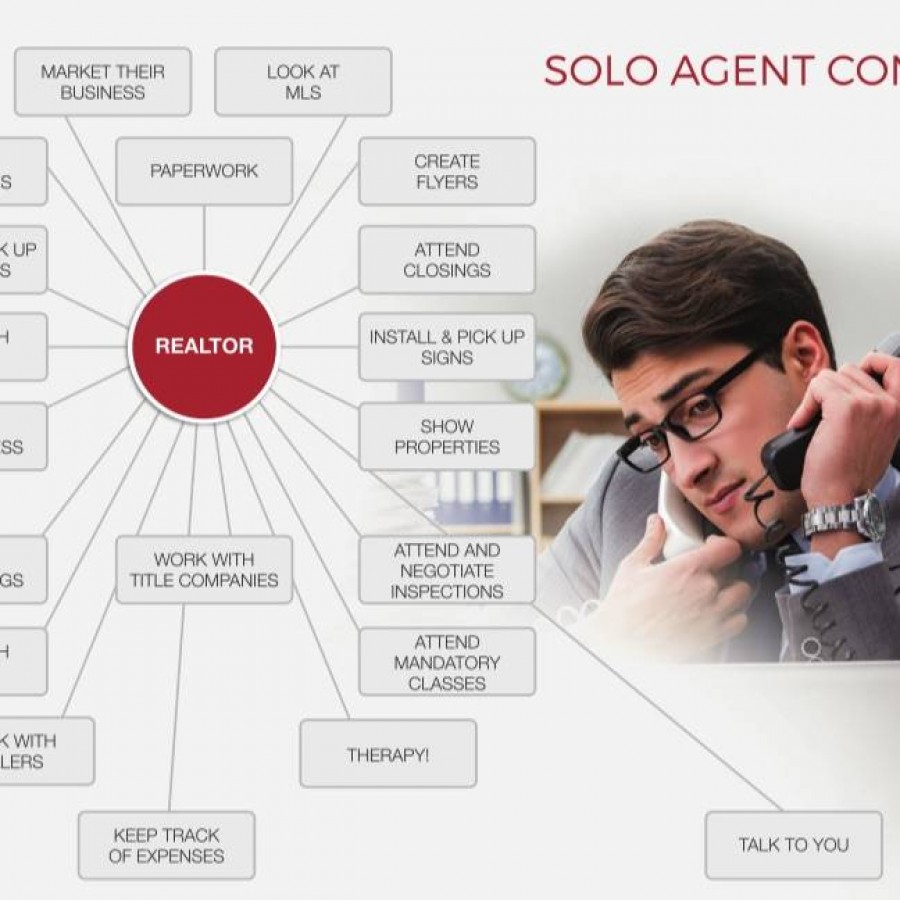

When performing a task in your career (or even when you’re doing something as simple as shooting a basketball), how many times do you have to practice before you become proficient?
50? 100? 500?
The average Houston listing agent has sold less than 5 homes in their entire life.
How do you become great at something that you’ve never practiced?
Here are a few statistics to understand the complexity associated with correctly selling your home fast and for the most money:
The Redlux Properties Team has sold over $1 billion of Houston residential real estate and regularly sells over 300 homes per year.
Our listing checklist has 9 phases and 457 rows (developed over the last 15 years)
How important are photos in selling a house in Houston? Let’s look at the numbers:
Originally we featured BEFORE and AFTER photos (and highlighted how much faster the “after” photos helped sell the home) in this section. Since these are real images from real listings, we didn’t want to “poke anyone in the eye.”
Below, please find sample “AFTER” images.

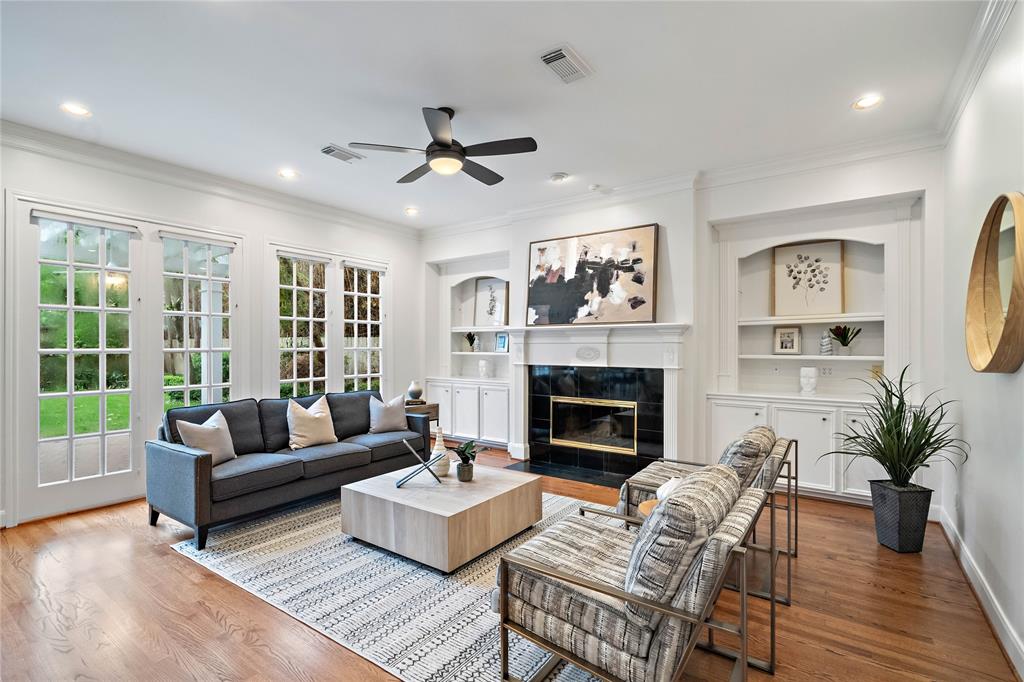



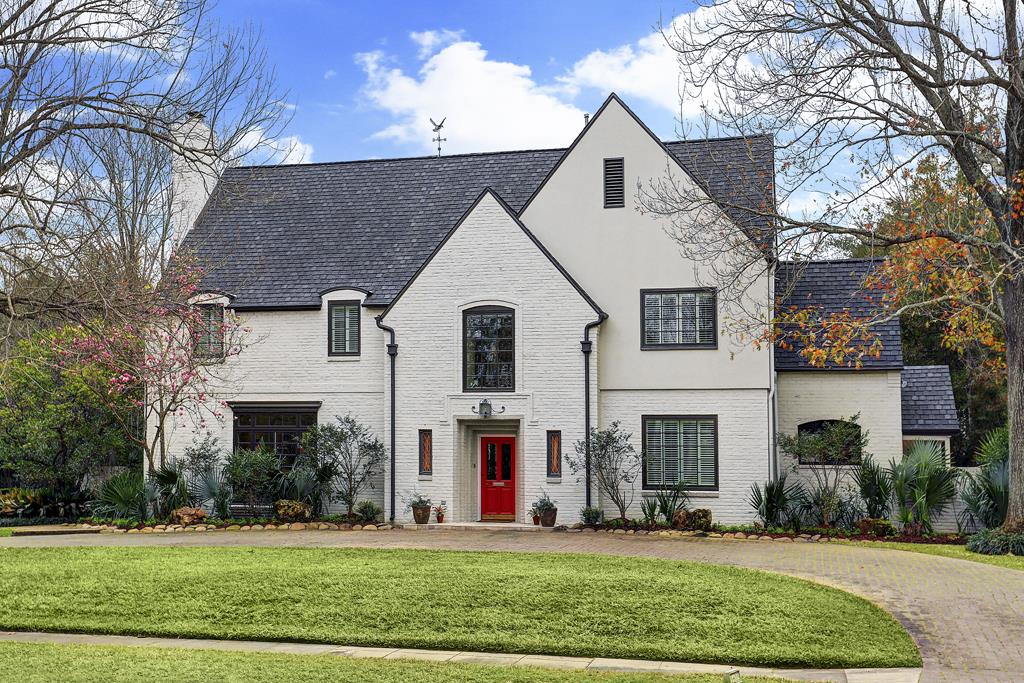
One of the more costly mistakes when selling your Houston home is not maximizing the number of photos for a listing.
We analyzed 16,083 Houston homes for sale. Homes that had about 8 photos in their listings stayed on the market for an average of 134 days.
On the other hand, homes with 15+ photos in their listings stayed on the market for only an average of 96 days. That’s more than a month’s difference in terms of turnaround time!
Other key findings include:
While we don’t have a long-term research study to back up the facts, our current experience tells us that listings should have more or less 40 photos.
With an agent who has more than $4M in sales per year and a team of professional photographers, you’re looking at the winning combination for staging your home for sale.
If the specific property doesn’t have 50 interior photos that represent the house in the best light, the other slots can be used to:
If you want to take your home staging up a notch, make sure to hire the best Houston listing Realtor who insists on including neighborhood or “lifestyle” shots that showcase the amenities of your neighborhood.
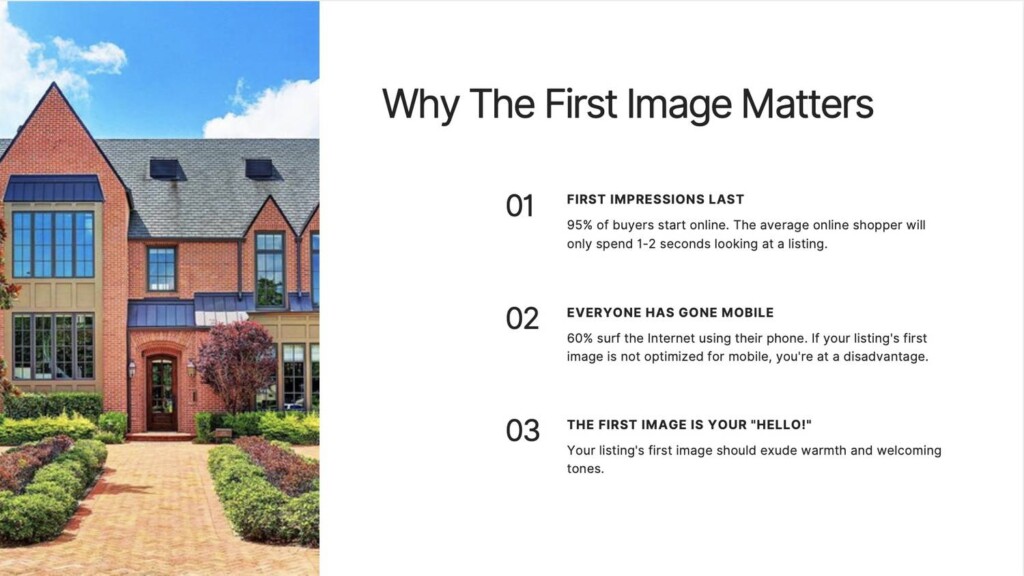
95% of buyers start their search online and view more than 85 listings before deciding on a home.
The primary goal of the first image is to draw in potential buyers. A good opening photo encourages the viewer to click on your listing and read more about the property.
The latest Google Advertising Study (which analyzed over 1 billion real estate images) showed that people were 25% more likely to click on an exterior photo of a home than an interior photo.
Based on our analysis, 67% of Houston home listings featured the exteriors of their homes in their first photos. 33% displayed the homes’ interiors as the first photos.
Our photography team is skilled at capturing photos that:
Our team also tracks the click-through rates based on the first photo. This lets us adjust our photo strategy according to feedback from your potential buyers. We give them an updated listing — with an even more awesome first photo, and you get more traffic for your property.
We also take advantage of the latest technology, like drone shots and virtual stagings, to showcase the best of your home.
Not taking advantage of good keywords is one of the biggest mistakes to avoid when selling your Houston home. Since 95% of home buyers use the Internet for their primary searches, you need to make sure your property listing is visible. To do that, you want to be on the top results of Google and other search engines. Listings with better keywords will appear more often in searches.
Listings with no mistakes in the form will have a better chance of appearing in all filters. For example, if a property is a townhome but is incorrectly listed as SFH, townhome buyers won’t be able to find the listing because it has the wrong category.
The quality of the keywords you include in your listing is also more relevant now. This is because HAR rolled out a “search bar” that helps buyers filter homes according to their desired features or locations.
Buyers and agents can now search for specific keywords such as “jacuzzi tub”, “fenced courtyard” or “Heights patio home” to narrow down their options. Including relevant and popular keywords in your listing increases the chances of your property appearing when buyers search online.
In our analysis of 1,000 homes for sale, we observed that 11.2% of listings on HAR did not utilize the executive summary section. This serves as the primary description field of your home and can accommodate text consisting of up to 1,000 characters.
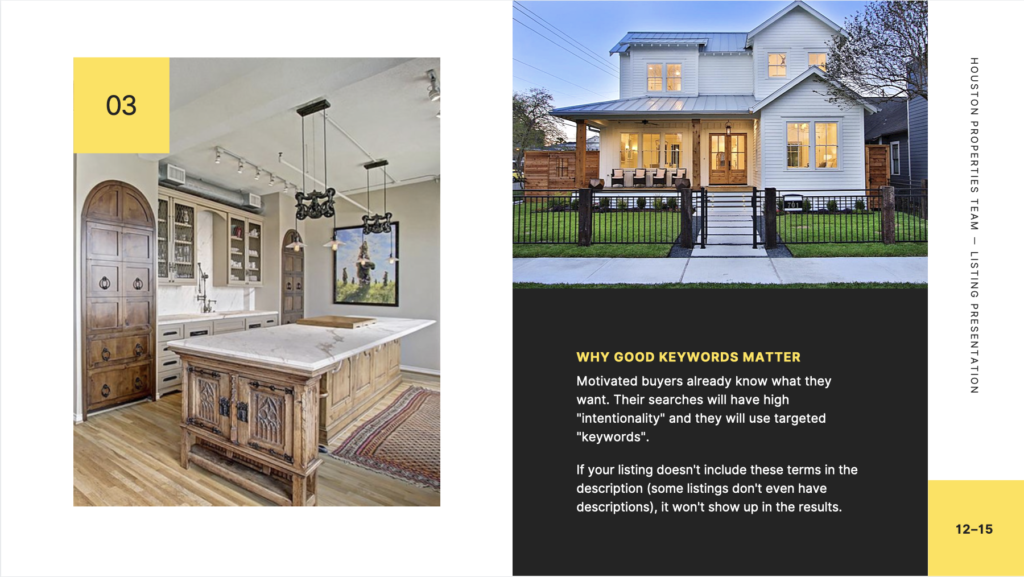
Based on our analysis, we came up with these tips to help you maximize the quality of your listing’s keywords:
1. Highlight your best home features.
Once you’ve identified the best features of your home, rank them according to what you think is the most important for your buyers and include them in your primary description.
2. Find the king among your keywords.
For example, instead of using “Beautiful Mason’s Home in Houston” as your title, you could go with “Flood-free and Spacious Mason’s Home in East Downtown” instead.
3. Proofread your descriptions.
Lack of grammar know-how shows that you didn’t put enough effort and attention into your listing. This might affect what buyers think about the state of your home as well. Proofreading is an easy step you can take to improve the quality of your keywords and listing descriptions.
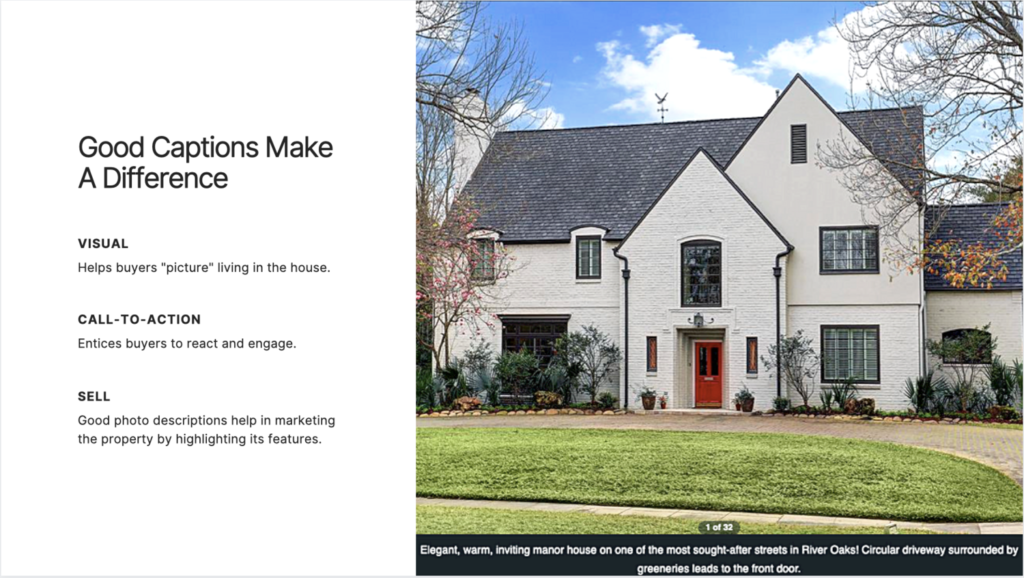
Lorem ipsum dolor sit amet, consectetur adipiscing elit. Ut elit tellus, luctus nec ullamcorper mattis, pulvinar dapibus leo.
Buyers’ feedback is an important source of what you’re doing right and what you could do better.
In contrast, no feedback is a warning sign that your property isn’t generating interest. At this point, you should re-evaluate your home and consider making staging modifications or offering a more attractive price.
You need reliable and accurate data to judge which feedback you should listen to or disregard. The Redlux Properties team excels in tracking several data points about your property so that you can act with confidence.
We make sure to keep an eye out for these 5 crucial data points:
For instance, we know that the Heights’ popularity as a neighborhood means stiff competition from other listings. Our previous sales show that it takes 5,000 marketing views to gain 10 showings, which should later result in 1 solid offer.
Every neighborhood operates at different stakes. We track all of our data and make sure you know them as well so that we can adjust your listing appropriately and prove to buyers why your home is the best choice.
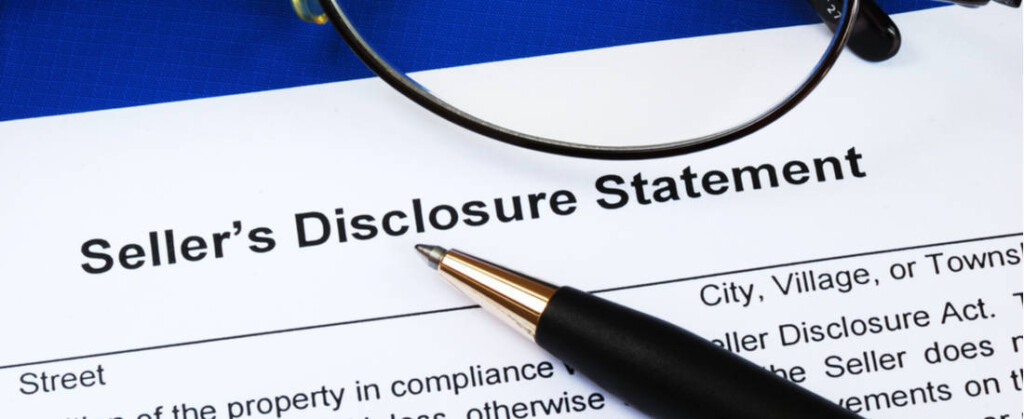
Texas State law requires sellers to provide their buyers with a completed Seller’s Disclosure.
Sec. 5.008 states that sellers of “residential real property comprising not more than one dwelling unit” should complete their Seller’s Disclosure.
On the other hand, duplexes, multiplexes, foreclosures, and the transfer of a property from one co-owner to another do not require so.
The Texas Real Estate Commission (TREC) composed the basic seller’s disclosure, but many real estate agencies have their own compliant versions.
You can use this document to support accurate pricing and fair contract terms, making the selling process smoother for everyone involved. It works as a comprehensive overview of a property that buyers want.
Buyers can check the seller’s disclosure to learn as much as they can about the intricacies of the property, its condition, as well as the state of the neighborhood it’s in, and its immediate surroundings.
The document also serves as a tool for transparency and risk reduction. The buyer and seller can settle any potential misunderstanding about the property if it was identified in the Seller’s Disclosure.
Include these 7 home features for a complete Seller’s Disclosure to meet legal requirements and buyer demands:
We have proven experience in helping sellers write the required documents to meet both legal requirements and buyer demands. Having a completed seller’s disclosure will help build your buyer’s confidence in you and help you sell your house fast.
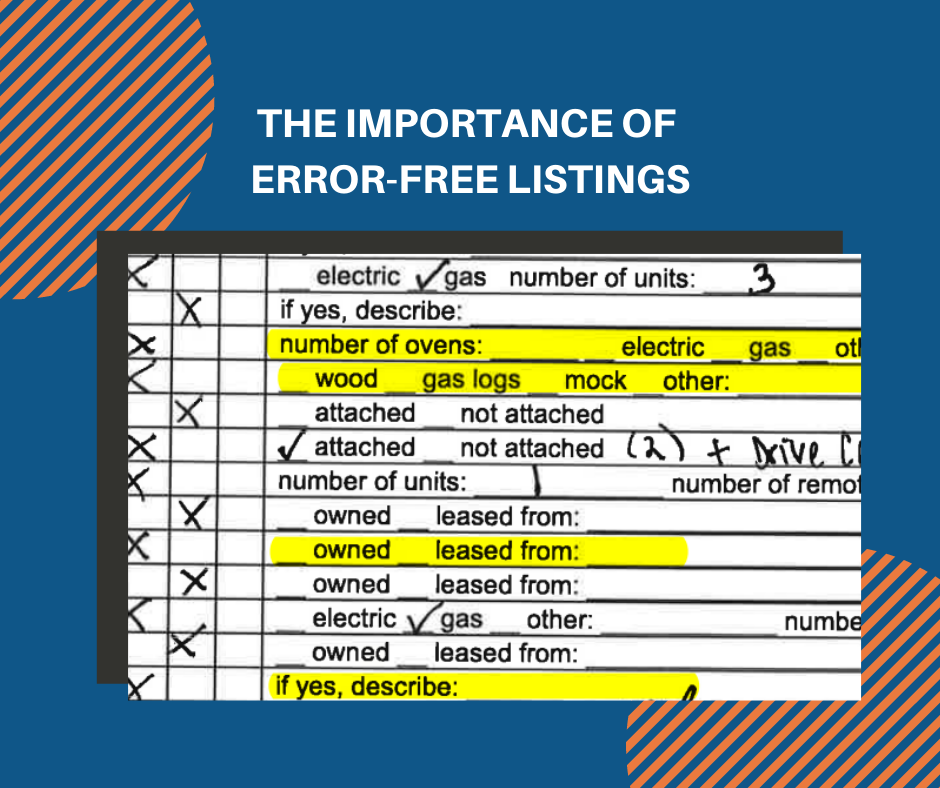
The best realtors know that providing buyers complete listings plus being knowledgeable about the Houston house selling process increases the chances of closing a sale.
Listing errors confuse buyers. Out of all the mistakes sellers make when selling a home, this is one that’s often overlooked but has costly consequences. In the last 10 years, nearly 50% of listings that didn’t sell had errors.
What makes it difficult to complete an error-free listing?
The Houston home selling process has a number of requirements with tedious processes.
Typically, there are 8 listing documents, excluding additional home documents for some properties.
Texas’ real estate listing forms are regularly updated. They also require realtors to pay subscription fees for their use.
Listing paperwork comprises about 35 pages and requires at least 18 initials or signatures.
The Seller’s Disclosure includes over 190 questions, while the HAR Multiple Listing Service has 290 listing fields that need to be filled up.
These fees and the paperwork can be taxing, so many agents fail to provide their clients with complete listings and documentation.
To give you an idea, these are the percentage rates of the most common listing errors that appeared on 300,000 Houston listings:
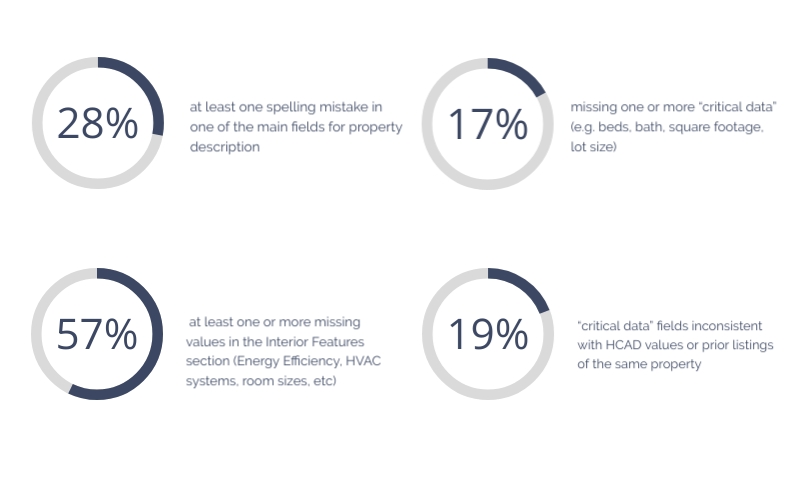
So, how crucial can listing errors be?
Here are some figures to help answer this question:
On average, listings with mistakes sold for 2.3% less and 47% slower than homes with complete listings.
Agents who committed 87% of listing mistakes produced less than $4M in sales per year.
In Houston, there are over 30,000 Realtors. Only about 10% of these agents were responsible for 90% of the transaction volume.
Statistically, these top 10% of agents were 72% less likely to have mistakes in their listings as compared to the other 90% of agents in Houston.
It might be tedious, but having an accurate and complete listing helps buyers learn more about your property and makes the selling process smoother in the long run.
One of the most common mistakes when selling a home is overpricing properties.
Sellers tend to overprice because they want the best return for their investment. Some also believe that the work they’ve put into their properties over the years should translate to an increase in value.
While it’s understandable that you would want to sell your home for the most money, the strategy of ramping up the price, so you can reduce it later on, has proven to be quite risky.
One of the most common mistakes when selling a home is overpricing properties.
Sellers tend to overprice because they want the best return for their investment. Some also believe that the work they’ve put into their properties over the years should translate to an increase in value.
While it’s understandable that you would want to sell your home for the most money, the strategy of ramping up the price, so you can reduce it later on, has proven to be quite risky.
Here are a couple of figures we gathered from analyzing 815,494 Houston homes:
-On average, properties that stayed on the Houston real estate market for more than 90 days sold for 1.3% LESS than the median sale price, despite being priced 2.2% HIGHER when they were originally listed.
-Properties that did the worst started by overpricing by 10% or more.
What happens when you overprice your home?
Putting up a price that’s too high and too far from your home’s market value can produce a number of negative effects on your home selling experience.
It will take a lot longer to sell, and you’ll most likely end up selling much lower. Overpriced homes sit longer on the market. The longer it sits on the market, the more price reductions it will be prone to. Consequently, the seller ends up losing both money and valuable time.
It can ward off potential buyers. With your home priced unusually higher than similar properties in the area, buyers could steer clear of your listing. Good agents can easily spot overpriced homes, and even without one, buyers simply want a good deal.
With your listing going stale, buyers will fail to see its value. If you see a listing that’s been up for a long time, you’ll most likely ask, “What’s wrong with this home?” In effect, buyers will feel like they have the upper hand if they do decide to make an offer.
It won’t show up in the right search results. 50% of buyers use the internet to look for a home. Most websites have filters they can change, such as the amount they’re willing to spend. If you overprice your home, you might lose a big chunk of buyers at your price point.
It might attract the wrong buyers. On the other hand, your overpriced home might show up in buyers with higher budgets, but also have higher expectations. Your home will end up being compared to properties with bigger and better features. As a result…
It ends up selling the competition. Whether the right or the wrong audience sees it, your competitors will appear to have the better deal. Properties in your price range will seem cheaper, and properties above it will seem to have better features.
Our research team had a fun time with this project.
We tackled this from two main approaches:
1) We exported all HAR recorded listings with:
a) Status of either Sold, Terminated, or Expired
b) Since January 1, 2000
c) From Houston Key Map MLS areas 1,2,3,4,5,6,7,8,9,10,11,12,13,14,15,16,17,18,20,21,22,23,24,25,28,29,34,35,36,37,38
d) List price above $140,000
e) Property type equal to either Single Family, Townhome, or Highrise Condo
f) Not listed “At Lot Value” (if a single family home)
We then aggregated this data into groups that had the same:
a) Property Type (e.g. comparing townhomes to townhomes)
b) Geo Market Area (areas defined by the HAR MLS Committee to separate the city)
c) Age (separated by decades, grouping all pre-1950 homes into the same age bracket)
Then we ran a regression analysis against the exported HAR fields to identify the correlation between each field and the Sold Price Per Square Foot value.
This provided a lot of data.
We also made the determination to lump many of the most correlated fields into one category labeled “Avoid Mistakes.”
2) Best vs. Worst Comparison
Then, we gathered the list of the 50,000 sold properties (again grouped by Property Type, Geo Market, and Age) and pulled properties with the lowest sold price per square foot.
We called these “the bad examples.”
We pulled another list of 50,000 sold properties (again grouped by Property Type, Geo Market, and Age) and pulled properties with the highest sold price per square foot.
We called these “the good examples.”
Not only did we go through the representative HAR data fields, but we also manually reviewed samples (selected from regions where we have most of our team’s listings) and analyzed both qualitative and quantitative factors.
We compared the original list price vs. sold price, listing agents, listing marketing, listing photos, the process of scheduling appointments, along with about two dozen factors.
We then took that list and reviewed it with our experienced listing agents to determine:
